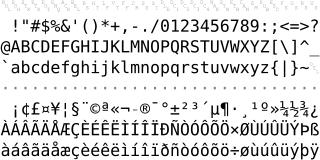Related Research Articles

Character encoding is the process of assigning numbers to graphical characters, especially the written characters of human language, allowing them to be stored, transmitted, and transformed using computers. The numerical values that make up a character encoding are known as code points and collectively comprise a code space, a code page, or character map.
While Hypertext Markup Language (HTML) has been in use since 1991, HTML 4.0 from December 1997 was the first standardized version where international characters were given reasonably complete treatment. When an HTML document includes special characters outside the range of seven-bit ASCII, two goals are worth considering: the information's integrity, and universal browser display.

ISO/IEC 8859-1:1998, Information technology—8-bit single-byte coded graphic character sets—Part 1: Latin alphabet No. 1, is part of the ISO/IEC 8859 series of ASCII-based standard character encodings, first edition published in 1987. ISO/IEC 8859-1 encodes what it refers to as "Latin alphabet no. 1", consisting of 191 characters from the Latin script. This character-encoding scheme is used throughout the Americas, Western Europe, Oceania, and much of Africa. It is the basis for some popular 8-bit character sets and the first two blocks of characters in Unicode.
A text file is a kind of computer file that is structured as a sequence of lines of electronic text. A text file exists stored as data within a computer file system.

Windows-1252 or CP-1252 is a legacy single-byte character encoding that is used by default in Microsoft Windows throughout the Americas, Western Europe, Oceania, and much of Africa.
ISO/IEC 8859-11:2001, Information technology — 8-bit single-byte coded graphic character sets — Part 11: Latin/Thai alphabet, is part of the ISO/IEC 8859 series of ASCII-based standard character encodings, first edition published in 2001. It is informally referred to as Latin/Thai. It is nearly identical to the national Thai standard TIS-620 (1990). The sole difference is that ISO/IEC 8859-11 allocates non-breaking space to code 0xA0, while TIS-620 leaves it undefined.
ISO/IEC 8859-7:2003, Information technology — 8-bit single-byte coded graphic character sets — Part 7: Latin/Greek alphabet, is part of the ISO/IEC 8859 series of ASCII-based standard character encodings, first edition published in 1987. It is informally referred to as Latin/Greek. It was designed to cover the modern Greek language. The original 1987 version of the standard had the same character assignments as the Greek national standard ELOT 928, published in 1986. The table in this article shows the updated 2003 version which adds three characters. Microsoft has assigned code page 28597 a.k.a. Windows-28597 to ISO-8859-7 in Windows. IBM has assigned code page 813 to ISO 8859-7. (IBM CCSID 813 is the original encoding. CCSID 4909 adds the euro sign. CCSID 9005 further adds the drachma sign and ypogegrammeni.)
Extended Unix Code (EUC) is a multibyte character encoding system used primarily for Japanese, Korean, and simplified Chinese (characters).

In computing and typesetting, a soft hyphen or syllable hyphen, is a code point reserved in some coded character sets for the purpose of breaking words across lines by inserting visible hyphens if they fall on the line end but remain invisible within the line.
The degree symbol or degree sign, °, is a glyph or symbol that is used, among other things, to represent degrees of arc, hours, degrees of temperature or alcohol proof. The symbol consists of a small superscript circle.
Windows code page 1253, commonly known by its IANA-registered name Windows-1253 or abbreviated as cp1253, is a Microsoft Windows code page used to write modern Greek. It is not capable of supporting the older polytonic Greek.
The currency sign¤ is a character used to denote an unspecified currency. It can be described as a circle the size of a lowercase character with four short radiating arms at 45° (NE), 135° (SE), 225° (SW) and 315° (NW). It is raised slightly above the baseline. The character is sometimes called scarab.
Several 8-bit character sets (encodings) were designed for binary representation of common Western European languages, which use the Latin alphabet, a few additional letters and ones with precomposed diacritics, some punctuation, and various symbols. These character sets also happen to support many other languages such as Malay, Swahili, and Classical Latin.
Mac OS Icelandic is an obsolete character encoding that was used in Apple Macintosh computers to represent Icelandic text. It is largely identical to Mac OS Roman, except for the Icelandic special characters Ý, Þ and Ð which have replaced typography characters.
KS X 1001, "Code for Information Interchange ", formerly called KS C 5601, is a South Korean coded character set standard to represent Hangul and Hanja characters on a computer.
In mathematics, the radical symbol, radical sign, root symbol, radix, or surd is a symbol for the square root or higher-order root of a number. The square root of a number x is written as
Mac OS Croatian is a character encoding used on Apple Macintosh computers to represent Gaj's Latin alphabet. It is a derivative of Mac OS Roman. The three digraphs, Dž, Lj, and Nj, are not encoded.
Mac OS Celtic is a character encoding used by Mac OS to represent Welsh text, replacing 14 of the Mac OS Roman characters with Welsh characters. This character set was developed by Michael Everson and was used for the Irish localizations of Mac OS 6.0.8 and 7.1 and for the Welsh localization of Mac OS 7.1.
Mac OS Gaelic is a character encoding created for the Irish Gaelic language, based on the Welsh Mac OS Celtic encoding but replacing 23 characters with Gaelic characters. It was developed by Michael Everson, and was in his CeltScript fonts and on some fonts included with the Irish localization of Mac OS 6.0.8 and 7.1 and on. FreeDOS calls it code page 58619.
Mac OS Maltese/Esperanto, called MacOS Esperanto in older sources, is a character encoding for Esperanto, Maltese and Turkish created by Michael Everson on August 15 1997, based on the Mac OS Turkish encoding. It is used in his fonts, but not on official Mac OS fonts.
References
- ↑ "Older Character Sets". whitefiles.org. Retrieved October 3, 2019.